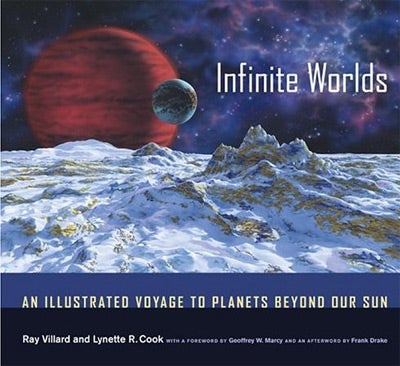Ray Villard and Lynette Cook, 252 pages, University of California Press, 2005; hardcover, $39.95
My initial thought the first time I picked up Ray Villard and Lynette Cook’s Infinite Worlds: An Illustrated Voyage to Planets Beyond Our Sun was how much their book reminded me of the classic work of Willy Ley and Chesley Bonestell.
I should not have been surprised that Infinite Worlds reminded me of Ley and Bonestell. As Villard notes in the book’s preface, it was the work of Ley and Bonestell that had inspired him. “It is our fondest wish that Infinite Worlds will inspire a new generation of dreamers who will actually take us to the stars,” writes Villard.
Villard and Cook have succeeded. Infinite Worlds is today’s The Conquest of Space. Aimed especially for high-school-age students (although totally enjoyable for any generation of reader), Villard and Cook take us on an inspiring scientific journey through the strange and alien universe unveiled by today’s space telescopes.
Villard, who is the news manager for the public information office of Baltimore’s Space Telescope Science Institute, where the Hubble Space Telescope is run, begins with the creation of the universe and ends with exciting contemplations about the possibility of life throughout the universe. Although grounded in fact, his speculations are sometimes startling and fascinating, such as when he considers the possibility of instantaneous communication and the existence of a galactic Internet, or when he wonders whether there are ancient, 10 billion-year-old civilizations hidden within the Milky Way’s oldest globular clusters.
| New Atlas of the Moon |
| Thierry Legault and Serge Brunier, 128 pages, 12 transparences, Firefly Books, 2006; hardcover, $55 |
 English-language readers now have an opportunity to fully appreciate New Atlas of the Moon, which originally was published in French. While you may find marginally more informative lunar atlases, you’d be hard-pressed to find a more attractive volume. With its intricate detail and wiro-binding, this atlas is designed for everyday use as a guide to our only satellite. The lunar photography and over-sized presentation allow this functional atlas also to serve as a coffee-table inhabitant. English-language readers now have an opportunity to fully appreciate New Atlas of the Moon, which originally was published in French. While you may find marginally more informative lunar atlases, you’d be hard-pressed to find a more attractive volume. With its intricate detail and wiro-binding, this atlas is designed for everyday use as a guide to our only satellite. The lunar photography and over-sized presentation allow this functional atlas also to serve as a coffee-table inhabitant.
The best feature of New Atlas of the Moon is the transparent overlays that accompany a dozen lunar views. They provide precise identification of features that many lunar atlases lack. The atlas’ cartography is designed for observers ranging from naked eye to binoculars to large scopes. New Atlas of the Moon hits bookshelves September 16, 2006.— Jeremy McGovern |
Along the way Cook, whose art has many times graced the pages of Astronomy magazine, provides stirring snapshots of these strange places. From visualizing what it would be like on a world in the central bulge of the Milky Way, with its night sky strewn with hundreds of stars brighter than Venus, to showing us the lonely, empty sky of a planet wandering starless between the galaxies, Cook reminds us the universe is often more exotic and beautiful than we can at first imagine.
Together, Villard and Cook have managed to create a breathtaking book that takes its readers on a fantastic voyage beyond our solar system, to worlds we can only now dream of visiting. Hopefully, they will succeed and inspire future generations to make it possible for us to go there.
— Robert Zimmerman is a regular contributor to Astronomy and the author of Leaving Earth: Space Stations, Rival Superpowers, and the Quest for Interplanetary Travel.










